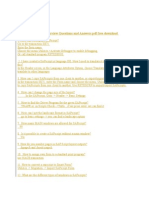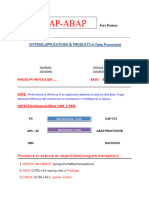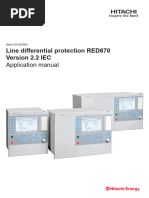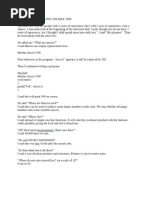0 ratings0% found this document useful (0 votes)
110 viewsSapscript Graphics: Sapscript Explained in Detail
This document summarizes SAPScript, which is used to generate forms and documents in SAP. It describes the transaction codes used to work with SAPScript, the different types of symbols used in SAPScript including system, standard, and program symbols. It also explains various control commands in SAPScript like INCLUDE, DEFINE, ADDRESS, PROTECT, NEW-PAGE, IF-ENDIF, and PERFORM for including text, defining variables, formatting addresses, ensuring text remains together across pages, inserting page breaks, conditional processing, and calling ABAP subprograms.
Uploaded by
Eye GreenCopyright
© Attribution Non-Commercial (BY-NC)
Available Formats
Download as DOCX, PDF, TXT or read online on Scribd
0 ratings0% found this document useful (0 votes)
110 viewsSapscript Graphics: Sapscript Explained in Detail
This document summarizes SAPScript, which is used to generate forms and documents in SAP. It describes the transaction codes used to work with SAPScript, the different types of symbols used in SAPScript including system, standard, and program symbols. It also explains various control commands in SAPScript like INCLUDE, DEFINE, ADDRESS, PROTECT, NEW-PAGE, IF-ENDIF, and PERFORM for including text, defining variables, formatting addresses, ensuring text remains together across pages, inserting page breaks, conditional processing, and calling ABAP subprograms.
Uploaded by
Eye GreenCopyright
© Attribution Non-Commercial (BY-NC)
Available Formats
Download as DOCX, PDF, TXT or read online on Scribd
You are on page 1/ 4
SAPScript
explained in detail .
SAPScript Graphics
Transaction Codes Used
SE71 : Form Painter
SE72 : Style Maintenance
SE73 : Font Maintenance
SE78 : Sapscript Graphics Management
RSTXLDMC : Import graphics as text .
SYMBOLS
Symbols are place holder for values in the forms and are filled during
print formatting e.g. &DATE& ,&KNA1-NAME& . They are case insensitive
and are surrounded by &.
There are 3 types of symbols
1) System Symbols
System symbols are system maintained and their value is provided
by the system. These are as follow:
DATE
TIME
HOURS
MINUTES
SECONDS
PAGE
NEXTPAGE
DAY
MONTH
YEAR
NAME_OF_DAY
SPACE
DEVICE
2)Standard Symbols
Standard sumbols are user maintained by using transaction SM30 .These symbols are
stored in table TTDG e.g &MFG& which
stands for ' Your's Faithfully ' .
3)Program Symbols
Program symbols are placeholder for database fields and global program symbols in the
print program e.g &KNA1-NAME1& here the table
KNA1 has alreadty been declared in the print program using TABLES statement.
CONTROL COMMANDS
Control Commands are used to change text output , these are used with
the format key /: in the format column
e.g. INCLUDE MYTEXT OBJECT TEXT ID ST
These are:
INCLUDE
DEFINE
ADDRESS ... ENDADDRESS
PROTECT ... ENDPROTECT
NEW-PAGE
IF ... ENDIF
CASE .... ENDCASE
PERFORM ... USING
INCLUDE name OBJECT name ID name PARAGRAPH name LANGUAGE name
Include command is used to include standard text in a form.the text
should be already defined by using transaction SO10.
Here name is the name of text
ID is used to classify text e.g. SDVD (SD related text) , ST (Standard text)
OBJECT is used to specify type of object it an be TEXT , DOKU
LANGUAGE is used to specify language like EN ,if ommited than logon
language is used
PARAGRAPH is used to specify the paragraph like C
e.g. /:INCLUDE mytext OBJECT TEXT ID ST LANGUAGE EN
Here the standard text created in SO10 with name mytext is
included in the form in language EN (English)
DEFINE
Define is used to define a symbol in the form i.e defining a variable and
giving it a value . e.g. /:DEFINE &NAME& = 'Niraj Visnoi'
/:DEFINE &SPECIAL& = ' 14 TH APRIL'
ADDRESS ... ENDADDRESS
ADDRESS and ENDADDRESS is used to specify the address which will
be formatted according to the target country i.e the recipient country.
e.g. /:ADDRESS sales PARAGRAPH C
/:NAME &KNA1-NAME1&
/:STREET &KNA1-STRAS&
/:POSTCODE &KNA1-PSTLZ&
/:CITY &KNA1-ORT01&
/:COUNTRY &KNA1-LAND1&
/:FROMCOUNTRY 'DE'
/:ENDADDRESS
PROTECT .... ENDPROTECT
The text which we want to be printed without any break i.e printed completely in a
page is
inserted between PROTECT and ENDPROTECT . If sapscript finds that the text
cannot be printed on that page completely a implicit page break occurs and the text is
printed on the next page
NEW-PAGE
NEW-PAGE is used to insert a page break ,it can be conditional if used between
IF..ENDIF
e.g. /:IF &KNA1-NAME1& = 'NIRAJ'
/:NEW-PAGE
/:ENDIF
IF ... ENDIF
IF ... ENDIF is used in the same way as in ABAP , a condition is tested and if it is
true
all the statements between IF and ELSE are executed otherwise statements between
ELSE
and ENDIF are executed, ELSE is optioonal.
/:IF condition
..
..
/:ENDIF
or
/:IF condition
..
ELSE
..
/:ENDIF
CASE ... ENDCASE
It si similar to multiple IF.. ENDIF's but is much cleaner.
/:CASE condition
/:WHEN value1
...
/:WHEN value2
...
...
/:ENDCASE
TIME/DATE/COUNTRY Formats
These commands are used for specifying the format of date and
time and setting the default country.
/:SET DATE MASK = 'MM.DD.YYYY'
/:SET TIME MASK = 'HH:MM'
/:SET COUNTRY 'DN'
PERFORM ... IN PROGRAM .... USING.. CHANGING ..
ENDPERFORM
To call ABAP subroutines from within a form we use the
PERFORM... IN PROGRAM ... statement , the advantage of
using it is that the print program is not required to cahnge and we
can get the new data from the subroutine which is placed in a Z
report . To pass and get the values from th subroutine the
parameters are passed which are of type structure ITCSY.
e.g. /:PERFORM get_date IN PROGRAM zreport
/:USING &SALESORDER&
/:CHANGING &S_DATE&
/:ENDPERFORM
The date &S_DATE& ....
The ABAP Code would be
REPORT zreport.
TABLES ztab.
FORM get_date TABLES in_tab STRUCTURE ITCSY out_tab
STRUCTURE ITCSY .
READ TABLE in_tab INDEX 1.
SELECT some_date FROM ztab WHERE salesorder = in_tab-value.
IF sy-subrc EQ 0.
READ TABLE out-tab INDEX 1.
MOVE ztab-somedate TO out_tab-value
MODIFY out_tab INDEX 1.
ENDIF.
ENDFORM.
In the above code USING is used to pass the value to the
subroutine while changing is used to recieve the value from th
subroutine ,for further paramters we can use either USING or
CHANGING .
In the subroutine the type of paramter is always an internal table of
type ITCSY irrespective of the value passed.The VALUE field
of the internal table is used to fill and recieve the values .
You might also like
- Q1.An Animal Feed Company Must Produce at Least 200 Kgs of A Mixture Consisting of IngredientsNo ratings yetQ1.An Animal Feed Company Must Produce at Least 200 Kgs of A Mixture Consisting of Ingredients13 pages
- Sapscript Graphics: Transaction Codes UsedNo ratings yetSapscript Graphics: Transaction Codes Used4 pages
- Chapter 03 - Coding in The SAPScript EditorNo ratings yetChapter 03 - Coding in The SAPScript Editor25 pages
- SAP ABAP Scripts Interview Questions and Answers PDFNo ratings yetSAP ABAP Scripts Interview Questions and Answers PDF6 pages
- Sapscript Formatting Options Available in SapscriptNo ratings yetSapscript Formatting Options Available in Sapscript5 pages
- ABAP Basics: ABAP Stands For Advanced Business Application Programming. It Is A ProgrammingNo ratings yetABAP Basics: ABAP Stands For Advanced Business Application Programming. It Is A Programming18 pages
- Report On The Things I Have Covered in ABAP: Advanced Business Application ProgrammingNo ratings yetReport On The Things I Have Covered in ABAP: Advanced Business Application Programming11 pages
- SAP Scripts: 1.differences Between Reports and Scripts ?No ratings yetSAP Scripts: 1.differences Between Reports and Scripts ?35 pages
- Programming Techniques: There Are 3 PartsNo ratings yetProgramming Techniques: There Are 3 Parts4 pages
- Sap Scripts Tutorial: Se71, Se78, Scc1, Vf03, So10: Components of SapscriptNo ratings yetSap Scripts Tutorial: Se71, Se78, Scc1, Vf03, So10: Components of Sapscript6 pages
- Cryptocurrencies and Blockchain Technologies: Dan Boneh Benedikt Bünz Stanford UniversityNo ratings yetCryptocurrencies and Blockchain Technologies: Dan Boneh Benedikt Bünz Stanford University41 pages
- About Me Educational Backgrounds: Bachelor Degree in Mechanical EngineeringNo ratings yetAbout Me Educational Backgrounds: Bachelor Degree in Mechanical Engineering2 pages
- Hitachi Energy - RED670 (Application Manual) - UnlockedNo ratings yetHitachi Energy - RED670 (Application Manual) - Unlocked900 pages
- As 4594.1-1999 Internal Combustion Engines - Performance Standard Reference Conditions Declarations of PowerNo ratings yetAs 4594.1-1999 Internal Combustion Engines - Performance Standard Reference Conditions Declarations of Power8 pages
- MECH550P: Foundations in Control EngineeringNo ratings yetMECH550P: Foundations in Control Engineering17 pages
- Lecture 3 - Framework For Project ManagementNo ratings yetLecture 3 - Framework For Project Management51 pages
- CT3223-07 New Brilliance 64-channel DMS Module ClassificationNo ratings yetCT3223-07 New Brilliance 64-channel DMS Module Classification4 pages
- Q1.An Animal Feed Company Must Produce at Least 200 Kgs of A Mixture Consisting of IngredientsQ1.An Animal Feed Company Must Produce at Least 200 Kgs of A Mixture Consisting of Ingredients
- SAP ABAP Scripts Interview Questions and Answers PDFSAP ABAP Scripts Interview Questions and Answers PDF
- Sapscript Formatting Options Available in SapscriptSapscript Formatting Options Available in Sapscript
- ABAP Basics: ABAP Stands For Advanced Business Application Programming. It Is A ProgrammingABAP Basics: ABAP Stands For Advanced Business Application Programming. It Is A Programming
- Report On The Things I Have Covered in ABAP: Advanced Business Application ProgrammingReport On The Things I Have Covered in ABAP: Advanced Business Application Programming
- SAP Scripts: 1.differences Between Reports and Scripts ?SAP Scripts: 1.differences Between Reports and Scripts ?
- Sap Scripts Tutorial: Se71, Se78, Scc1, Vf03, So10: Components of SapscriptSap Scripts Tutorial: Se71, Se78, Scc1, Vf03, So10: Components of Sapscript
- "C Programming for Beginners: A Step-by-Step Guide"From Everand"C Programming for Beginners: A Step-by-Step Guide"
- Cryptocurrencies and Blockchain Technologies: Dan Boneh Benedikt Bünz Stanford UniversityCryptocurrencies and Blockchain Technologies: Dan Boneh Benedikt Bünz Stanford University
- About Me Educational Backgrounds: Bachelor Degree in Mechanical EngineeringAbout Me Educational Backgrounds: Bachelor Degree in Mechanical Engineering
- Hitachi Energy - RED670 (Application Manual) - UnlockedHitachi Energy - RED670 (Application Manual) - Unlocked
- As 4594.1-1999 Internal Combustion Engines - Performance Standard Reference Conditions Declarations of PowerAs 4594.1-1999 Internal Combustion Engines - Performance Standard Reference Conditions Declarations of Power
- CT3223-07 New Brilliance 64-channel DMS Module ClassificationCT3223-07 New Brilliance 64-channel DMS Module Classification

























































































